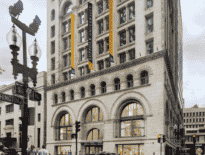U.S. retail sales tumbled by a record 16.4 percent from March to April as business shutdowns caused by the coronavirus kept shoppers away, threatened the viability of stores across the country and further weighed down a sinking economy.
The Commerce Department’s report Friday on retail purchases showed a sector that has collapsed so fast that sales over the past 12 months are down a crippling 21.6 percent. The severity of the decline is unrivaled for retail figures that date back to 1992. The monthly decline in April nearly doubled the previous record drop of 8.3 percent – set just one month earlier.
“It’s like a hurricane came and leveled the entire economy, and now we’re trying to get it back up and running,” said Joshua Shapiro, chief U.S. economist for the consultancy Maria Fiorini Ramirez.
Shapiro said he thinks retail sales should rebound somewhat as states and localities reopen their economies. But he said overall sales would remain depressed “because there is going to be a big chunk of the lost jobs that don’t come back.”
The sharpest declines from March to April were at clothing, electronics and furniture stores. A long-standing migration of consumers toward online purchases is accelerating, with that segment posting a 8.4 percent monthly gain. Measured year over year, online sales surged 21.6 percent.
Other than online, not a single retail category was spared in April. Auto dealers suffered a monthly drop of 13 percent. Furniture stores absorbed a 59 percent plunge. Electronics and appliance stores were down over 60 percent. Retailers that sell building materials posted a drop of roughly 3 percent. After panic buying in March, grocery sales fell 13 percent.
Clothing-store sales tumbled 79 percent, department stores 29 percent. Restaurants, some of which are already starting to close permanently, endured a nearly 30 percent decline despite shifting aggressively to takeout and delivery orders.
For a retail sector that had already been reeling, a back-to-back free-fall in spending poses a grave risk. Department stores, restaurants and auto dealerships are in danger. Nearly $1 of every $5 spent at retailers last month went to non-store retailers, evidence that the pandemic has accelerated the shift toward online shopping.
In the past two weeks, J.Crew, Neiman Marcus and Stage Stores have filed for bankruptcy protection. J.C. Penney appears on the verge of following them. UBS estimates that roughly 100,000 stores could shutter over the next five years.
“The whole economic model is unraveling,” Neil Saunders, managing director of GlobalData Retail. “This is going to be very painful. For some, it’s going to be fatal.”
Retailers are being imperiled not only by business shutdowns mandated by states and localities but also by a record loss of 36 million jobs over the past two months. The unemployed typically pull back sharply on retail purchases.
An April analysis by a group of academic economists found that a one-month closure could wipe out 31 percent of non-grocer retailers. A four-month closure could force 65 percent to close.
The plunge in retail spending is a key reason why the U.S. economy is contracting. Retail sales account for roughly half of all consumer spending, which fuels about 70 percent of economic activity. The rest of consumer spending includes services like cellphone and internet contracts, gym memberships and child care, as well as home sales, which plunged in March.
With few Americans shopping, traveling, eating out or otherwise spending normally, economists have estimated that the gross domestic product – the broadest gauge of economic activity – is shrinking in the April-June quarter at a roughly 40 percent annual rate. That would be the deepest quarterly drop on record.







